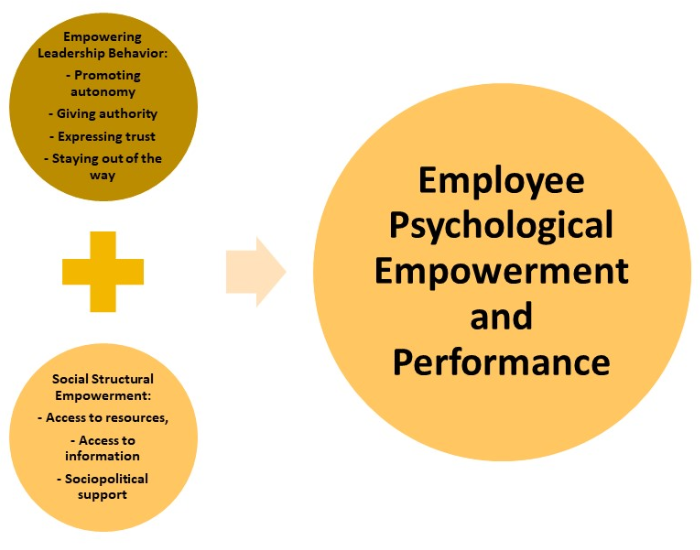
Ever heard from your boss: “I fully trust and empower you to get this job done well!” but then were left without the support, information, or resources needed to actually get it done?
Organizations increasingly attempt to reorganize themselves — to decentralize leadership and become more agile and team-based (e.g., ING Bank, Spotify). To this end, company leaders often preach empowerment, which is a proactive orientation towards one’s work role (as compared to a passive and resigned mentality at work, akin to quiet quitting). This proactive mindset of psychological empowerment comprises four important motivational forces that can promote thriving at work: (1) the feeling of having an impact, (2) a sense of being competent and capable, (3) experiencing one’s job as meaningful, and (4) a sense of self-determination in one’s work.
To achieve these feelings of empowerment in their workforce, senior executives encourage managers to engage in “empowering leadership behavior,” a set of behaviors (e.g., sharing autonomy and authority, promoting participative decision-making and expressing confidence and trust in subordinates’ high-performance capabilities) intended to promote employee self-direction. These top executives are 100% right in doing so. An abundant body of research speaks to empowering leadership’s many benefits, including increased employee performance and creativity.
However, according to abundant anecdotal evidence gathered across many consulting projects by renowned management scholars (e.g., Argyris, Forrester), efforts to implement empowerment in organizations frequently fail or fall short of the expected results. Given the widespread use of agile methods and attempts to empower workforces today, this problem seemed highly relevant for organizational leaders across the board. In light of this, my co-author Brad Kirkman and I began to reflect on why organizations struggle to successfully implement such a potent idea as empowerment.
In searching for answers, we had many conversations with participants in our executive education programs. Often, they would tell us that they experience empowerment in their own organizations as somewhat “fake” because, despite all the talk about empowerment, “nothing really changes.” Or they would mention that leaders, albeit praising the idea of empowerment in theory, would just not go far enough and change the necessary structures and procedures. In fact, this anecdotal evidence aligned well with what the late business theorist and professor emeritus at Harvard Chris Argyris had once noted: that “managers love empowerment in theory, but the command-and-control model is what they trust and know best.” Likewise, Kotter, famous for his 8-steps to transforming an organization program, has claimed that obstacles to new visions, such as structures or systems, are often not altered, creating situations in which managers pay lip service to advocated behavior.
Based on these conversations we concluded that one likely key reason for the frequent failure of empowerment initiatives is that they are often not far-reaching enough. Neglecting social structural features, that is, access to key resources, important information and sociopolitical support becomes what we call the “forgotten side” of empowerment. According to Argyris, when executives do not adjust these social structural features in tandem with an empowerment initiative ensuring they go hand in hand with managers’ empowering behavior, employees will inadvertently “see vestiges of the old command-and-control model as confirming their worse suspicions — that superiors want unchallenged power.” In other words, empowerment initiatives are most likely “doomed to fail” if executives don’t address multiple empowerment elements in their organizations while encouraging their managers to enact empowering leadership behaviors.
To explore our main research question — that a lack of social structural empowerment could inadvertently suppress or even neutralize the positive effects of empowering leadership behavior on employee psychological empowerment and downstream employee performance — we conducted four complementary studies using a variety of samples (amounting to a total pool of respondents of 1,127) and methodologies (including time-lagged survey studies, an experiment, and an organizational field study).
Across our studies, we consistently found that the effect of leader empowering behavior on employee psychological empowerment can inadvertently be weakened (and indeed be fully suppressed!) when employees’ jobs lack the social structural aspects needed to perform in empowered roles. In other words, we found that empowering leadership was entirely ineffective when decoupled from necessary structural improvements. This implies that the millions in financial resources spent on leadership training and development that are aimed at making leaders more empowering might be spent on a lost cause. More generally, our findings imply that organizations must realize that their leaders’ empowering behavior and the social structural conditions they create for employees’ jobs are interdependent (rather than independent) factors that affect employee empowerment.
Although company executives often preach employee empowerment, such initiatives frequently fail or fall short of expected results. According to our research, one key reason for the failure of empowerment initiatives is that such initiatives in many instances are likely not far-reaching enough. Through their empowering behavior, leaders have a direct impact on employees’ well-being, such as their proactive orientation towards their jobs, their sense of meaningfulness, competence, impact, and autonomy. However, when organizations do not align their social structural features — access to resources, access to information and sociopolitical support — they effectively support leaders’ empowering behavior and employees will inadvertently see vestiges of the old command-and-control model. In this case, leaders’ empowering behavior will not allow employees to “work well” by feeling psychologically empowered. Simply put, empowering leadership is ineffective in situations where social structural empowerment is not present. Therefore, organizations’ top executives must realize that leader empowering behavior and social structural conditions are interdependent factors for employee empowerment — and that both must be enhanced for the benefits of empowering leadership on employee well-being and performance to materialize.

Dennerlein, T., & Kirkman, B. L. (2023). The forgotten side of empowering others: How lower social structural empowerment attenuates the effects of empowering leadership on employee psychological empowerment and performance. Journal of Applied Psychology. Advance online publication. https://doi.org/10.1037/apl0001100
Tobias Dennerlein is an Assistant Professor of Management in the Organizational Behavior and Human Resources area at Purdue's Mitchell E. Daniels, Jr. School of Business